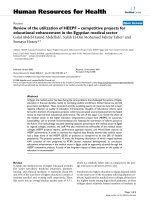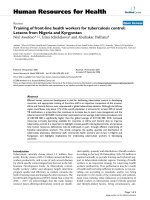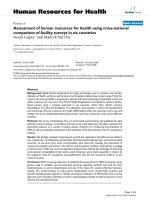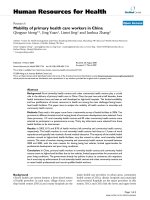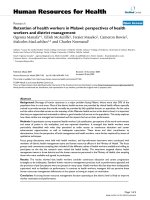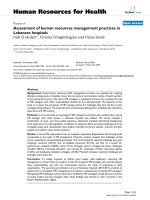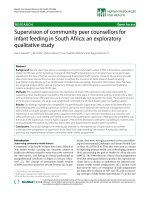Báo cáo sinh học: " Characterisation of parapoxviruses isolated from Norwegian semi-domesticated reindeer (Rangifer tarandus tarandus)" ppt
Bạn đang xem bản rút gọn của tài liệu. Xem và tải ngay bản đầy đủ của tài liệu tại đây (1.51 MB, 10 trang )
BioMed Central
Page 1 of 10
(page number not for citation purposes)
Virology Journal
Open Access
Research
Characterisation of parapoxviruses isolated from Norwegian
semi-domesticated reindeer (Rangifer tarandus tarandus)
Joern Klein
1,2
and Morten Tryland*
1,3
Address:
1
Department of Microbiology and Virology, University of Tromsø, Breivika, N-9037 Tromsø, Norway,
2
Danish Institute for Food and
Veterinary Research, Department of Virology, Lindholm, DK-4771 Kalvehave, Denmark and
3
Section of Arctic Veterinary Medicine, Department
of Food Safety and Infection Biology, The Norwegian School of Veterinary Science, PO Box 6204, N-9292 Tromsø, Norway
Email: Joern Klein - ; Morten Tryland* -
* Corresponding author
Abstract
Background: Two outbreaks of the disease contagious ecthyma were reported in 1999 and 2000
in Norwegian semi-domesticated reindeer (Rangifer tarandus tarandus). Contagious ecthyma is an
epidermal disease of sheep and goats worldwide, which is caused by the zoonotic parapoxvirus orf
virus. Characterisation of clinical samples from the two outbreaks in semi-domesticated reindeer
in Norway by electron microscopy and PCR (B2L) revealed typical parapoxvirus particles and
partial gene sequences corresponding to parapoxvirus, respectively. If contagious ecthyma in
reindeer is caused by orf virus, the virus may be transferred from sheep and goats, via people,
equipment and common use of pastures and corrals, to reindeer. Another possibility is that
contagious ecthyma in reindeer is caused by a hitherto unclassified member of the parapoxvirus
genus that circulates among reindeer herds and remains endemic in Norway.
Results: Genomic comparisons of one standard orf strain (orf NZ2) and the reindeer isolates,
employing restriction fragment length polymorphism (RFLP) and random amplified polymorphic
DNA (RAPD) analysis, demonstrated high similarity between the reindeer viruses and known orf
virus strains. Partial DNA sequences of two different viral genes were determined for the different
isolates and compared with corresponding parapoxvirus genebank sequences. The comparison/
alignment and construction of phylogenetic trees also point to an affiliation of the reindeer viruses
to the species orf virus.
Conclusion: The results of this work imply that the parapoxvirus causing contagious ecthyma in
Norwegian semi-domesticated reindeer belongs to the species orf virus and that the orf virus
crosses the host species barrier from sheep and goat to semi-domesticated reindeer.
Background
Parapoxviruses (PPVs) (family Poxviridae) cause dermal
diseases most commonly in sheep, goats and cattle [2],
but also in semi-domesticated reindeer (Rangifer tarandus
tarandus) [3] and wildlife, like seals [4], red deer [5] and
squirrels [6]. The genus Parapoxvirus consists of five spe-
cies and three tentative species [7]: Bovine popular stoma-
titis virus (BPSV), orf virus (ORFV), parapoxvirus of red
deer in New Zealand (PVNZ), pseudocowpox virus
(PCPV), and squirrel parapoxvirus (SPPV), as well as the
tentative species of the genus: auzdyk disease virus, cham-
ois contagious ecthyma virus and sealpox virus.
Published: 05 September 2005
Virology Journal 2005, 2:79 doi:10.1186/1743-422X-2-79
Received: 28 June 2005
Accepted: 05 September 2005
This article is available from: />© 2005 Klein and Tryland; licensee BioMed Central Ltd.
This is an Open Access article distributed under the terms of the Creative Commons Attribution License ( />),
which permits unrestricted use, distribution, and reproduction in any medium, provided the original work is properly cited.
Virology Journal 2005, 2:79 />Page 2 of 10
(page number not for citation purposes)
The first documented outbreak of a contagious ecthyma-
like disease in Norwegian reindeer, took place in 1976
among experimental animals at the National Reindeer
Research Station in Lødingen [8]. Also human parapoxvi-
rus infections were associated with this outbreak [9]. In
April 1999, the first outbreak in reindeer under regular
herding conditions was reported in Troms County, fol-
lowed by an outbreak one year later, also in April, in Nor-
dland County. The outbreak in 2000 involved at least 30
out of 150 reindeer, which were corralled and supplemen-
tary fed during the winter. Seven of the infected animals
died, due to massive oral cauliflower-like lesions and sec-
ondary bacterial infections [1].
In Norway, there are both wild and semi-domesticated
reindeer. The latter is herded over an area of approxi-
mately 140.000 km
2
, which is about 40% of the mainland
area of Norway. Most reindeer herding is conducted by
the Saami people (indigenous people of Scandinavia),
and the most dense reindeer herding area is in Finnmark
county, Northern Norway, where the total number of ani-
mals is estimated to be around 140.000 animals (estimate
for 2003 [10]). Semi-domesticated reindeer have seasonal
migrations between winter (usually inland) and summer
(usually coastal areas) pastures, and the pastures are
organised in districts, reducing the contact between ani-
mals of different districts. However, sheep and goats also
use the coastal pastures during spring, summer and
autumn, and contact between different animal species is
possible. Furthermore, it is not uncommon to use the
same corrals and transport vehicles for reindeer and
sheep, and remaining scabs from sheep with contagious
ecthyma may as well be a source of infection for reindeer.
Since the disease contagious ecthyma and orf virus is
present among sheep and goats in most parts of the coun-
try, it is necessary to characterise the causative agent of
contagious ecthyma in reindeer, in order to find out
whether reindeer have their own parapoxvirus species,
like red deer in New Zealand [5], or whether a transmis-
sion of virus between sheep and goats and reindeer is
more likely.
Due to genetic heterogeneity within the genus, classifica-
tion of PPV remains problematic and relies mostly on the
source of the virus isolate; id est Parapoxviruses isolated
from sheep will be classified as orf virus, virus isolated
from cattle as pseudocowpox [11,12]. However, several
molecular techniques have been used to characterise para-
poxviruses. Inoshima et al. [13] reported a polymerase
chain reaction (PCR) protocol assumed to be able to
amplify all members of the parapoxvirus genus, based on
primers from the B2L gene encoding a major envelope
protein [14]. The gene region encoding a viral interleukin
10 orthologue (vIL-10) [15] has been used for characteri-
sation, in combination with sequencing of the amplified
DNA products. Restriction fragment length polymor-
phism (RFLP) has also been used to compare parapoxvi-
rus isolates [5,16], and can be conducted both on
genomic DNA as well as on smaller DNA fragments in
combination with PCR. Also random amplified polymor-
phic DNA analysis (RAPD) may be used for characterisa-
tion purposes, as reported as a useful technique for
comparing orthopoxviruses [17].
The aim of the present study was to characterise the caus-
ative agent of contagious ecthyma in semi-domesticated
reindeer in Norway, and to compare this virus with other
parapoxvirus isolates. This information is necessary to be
able to sort out whether reindeer are exposed to orf virus,
which is commonly affecting sheep and goats and also
present among muskoxen in Norway, to bovine papillar
stomatitis virus, which is present among cattle in Norway,
or whether reindeer hosts a specific parapoxvirus species.
Results
Restriction Fragment Length Polymorphism (RFLP)
analysis
RFLP patterns by the three restriction endonucleases, Hind
III, Eco R1 and BAM H1 display identical DNA fragment
patterns for orf virus and the parapoxvirus isolated from
semi-domesticated Norwegian reindeer (Figure 1).
Random Amplification of Polymorphic DNA (RAPD)
analysis
The RAPD patterns of the Finnish (Fi94.1Rt) and the Nor-
wegian (N99.1Rt, N00.1Rt) reindeer isolates are similar to
that of the orf viruses orf 11 and NZ2 and distinct to the
sealpox and pseudocowpox patterns (Figure 2).
Polymerase Chain Reaction (PCR)
The vIL-10 PCR and GIF PCR were able to amplify DNA
from all 25 isolates, whereas the B2L PCR did only
amplify DNA from 17 isolates (Table 1).
Phylogenetic analysis
The Bayesian tree based on the the partial sequences of the
B2L-gene (Figure 3) display species specific clustering of
the parapoxvirus-genus.
Six clusters, representing the squirrel parapoxviruses, seal
poxviruses, bovine papular stomatitis virus, pseudocow-
poxviruses, parapoxvirus of red deer in New Zealand, and
orf viruses were generated.
The Norwegian reindeer isolates clustered together with
orf virus isolates from different host species and geograph-
ical origins. Also the Finnish reindeer isolates from 1992
and 1994 were in conjunction with the orf virus isolates,
whereas more recent Finnish parapoxvirus isolates
Virology Journal 2005, 2:79 />Page 3 of 10
(page number not for citation purposes)
Restriction fragment length polymorphism (RFLP) analysis of the standard orf virus strain NZ2 and the Norwegian reindeer isolate from Troms county 2000 (bands indicated by arrows) displays identical cleavage patterns for the two virusesFigure 1
Restriction fragment length polymorphism (RFLP) analysis of the standard orf virus strain NZ2 and the Norwegian reindeer
isolate from Troms county 2000 (bands indicated by arrows) displays identical cleavage patterns for the two viruses.
Virology Journal 2005, 2:79 />Page 4 of 10
(page number not for citation purposes)
causing contagious ecthyma in reindeer have been charac-
terised as more related to pseudocowpoxviruses [18].
Phylogenetic analysis of interleukin 10 amino acid
sequences from a range of mammalian species and the
three translated viral interleukin 10 orthologue nucle-
otide sequences obtained from the two Norwegian
(N00.1Rt and N99.1Rt) and one Finnish (Fi94.1Rt) virus
isolates from semi-domesticated reindeer is shown in Fig-
ure 4. The positions of the viral IL-10 indicate a high sim-
ilarity to the corresponding genes (interleukin 10) of the
main hosts of orf virus, goat and sheep. (Figure 4).
Discussion
Based on RFLP patterns obtained from the Norwegian
reindeer isolates and orf NZ2, a close relationship
between these viruses can be assumed (Figure 1). The
RAPD patterns of the reindeer isolates and the standard
orf virus strains orf 11 and orf NZ2 show high similarity
in amplification patterns (Figure 2). This similarity is
Random amplified polymorphic DNA (RAPD) analysis of different parapoxvirusesFigure 2
Random amplified polymorphic DNA (RAPD) analysis of different parapoxviruses. Lane 1: reindeer Finland 1994, Lane 2: rein-
deer Norway 1999, Lane 3: reference strain orf 11, Lane 4: reindeer Norway 2000, Lane 5: orf virus NZ2, Lane 6: parapoxvirus
from Weddell seal, Lane 7: parapoxvirus from cattle, Norway, Lane 8: mock infected cells, Lane 9 and 10: 1 kb and 100 bp lad-
der, respectively. Bands indicate similar patterns for orf and reindeer viruses, whereas parapoxvirus from seal and cattle are
different.
Virology Journal 2005, 2:79 />Page 5 of 10
(page number not for citation purposes)
present in spite of the geographical distance between the
Norwegian isolates and the orf strains originating from
Great Britain and New Zealand.
Further, this work demonstrates that a virus species char-
acterisation based on the nucleotide sequence of the PCR-
product from the B2L-PCR is possible. This characterisa-
tion method is easy to perform, because the PCR product
is fast to obtain and to proceed.
The phylogenetic analysis of the partial B2L-gene
sequence from the Norwegian reindeer isolates shows that
these isolates can be allocated to the orf virus species.
However, the clade credibility value of 37 % also demon-
strate a close relationship between the two different para-
poxvirus species, orf and pseudocowpox virus.
Tikkanen et al. [18] demonstrated the affiliation of parap-
oxvirus isolates obtained from Finnish semi-domesticated
reindeer during the early outbreaks (1992–1994) in Fin-
land, to the orf virus species and from later outbreaks to
the pseudocowpox viruses, which is congruent with our
results.
The close clustering of the translated sequences obtained
from virus isolated from reindeer (two Norwegian; 1999,
2000, and one Finnish; 1994) with the amino acid
sequences of sheep and goat interleukin 10 demonstrate a
high relationship of the parapoxvirus isolated from rein-
deer to the main hosts of orf virus (sheep and goat). It
seems that the viral interleukin 10 orthologue of the rein-
deer isolates is highly adapted to the immune system of
sheep and goats, which also indicates that the reindeer
parapoxvirus belongs to the orf virus species.
Our results indicate that neither geographical distance,
nor crossing the host barrier from sheep or goat to semi-
domesticated reindeer did affect the characteristics of the
parapoxvirus orf virus investigated in this study.
The B2L PCR has previously been described as a tool to
amplify all species within the parapoxvirus genus [13].
However, we were not able to amplify B2L sequences from
nine of the twenty-five isolates included in our study.
Many members of the subfamily chordopoxvirinae show
genetic rearrangement at the terminal sequences of the
genome, which is thought to be an evolutionary mecha-
nism, allowing the virus to adapt to changes of the
immune response of the host [19]. Parapoxvirus
replicated in vitro show rearrangement of the left terminal
end of the viral genome, resulting in the deletion of three
genes (E2L, E3L, G1L) and 80 % of a fourth one, the G2L
[20-22]. All these four genes play a major role in virulence
and host specificity [23]. The B2L gene is localised beside
the left terminal end of the genome, so that heterogeneity
in the primer binding regions or complete deletion of the
Table 1: PCR and sequencing results obtained from parapoxvirus isolates of different species, reference orf virus strain (Orf 11) and an
orf virus vaccine strain (NZ2). Successful amplification is indicated by Genebank accession number
Signature Host Country of origin B2L-PCR vIL-10-PCR GIF-PCR
N99.1Rt Rangifer t. tarandus Norway AY605963 AY605995 AY605973
N00.1Rt Rangifer t. tarandus Norway AY605964 AY605994 AY605972
N00.2Rt Rangifer t. tarandus Norway AY605969 AY606005 AY605985
N03.8Rt Rangifer t. tarandus Norway AY605966 AY605992 AY606010
Fi94.1Rt Rangifer t. tarandus Finland AY605965 AY605993 AY605971
Fi92.1Rt Rangifer t. tarandus Finland AY605959 AY606001 AY605979
N79.1Bos Bos spec. Norway AY605960 AY606011 AY605980
N92.1Bos Bos spec. Norway AY605961 AY606002 AY605981
N83.1Bos Bos spec. Norway AY605970 AY606003 AY605982
N85.1Bos Bos spec. Norway - AY963707 AY605984
N71.1Bos Bos spec. Norway - AY606012 AY605983
N02.1Ch Capra hircus Norway - Not sequenced AY606013
N00.1Ch Capra hircus Norway - AY605999 AY605977
N94.1Om Ovibos moschatus Norway AY605962 AY605996 AY605974
N00.1Oa Ovis aries Norway AY605957 AY605998 AY605976
N86.1Oa Ovis aries Norway AY605968 AY606007 Not sequenced
N86.2Oa Ovis aries Norway AY605967
AY606008 AY605990
N03.1Oa Ovis aries Norway - AY963708 AY605991
Sc95.1Hg Halichoerus grypus Scotland U49845AJ622901 AY605997 AY605975
N03.1Lw Leptonychotes weddelli Antarctica AJ622900 AY606015 AY605989AY605989
Orf 11 Cell culture - AY605958
AY606000 AY605978
Orf NZ2 Vaccine - AY963706 AY606006 AY605988
Virology Journal 2005, 2:79 />Page 6 of 10
(page number not for citation purposes)
B2L gene, through the same rearrangement mechanisms
as in the left terminal region itself, can be the reason for
the negative results of the B2L-PCR. However, further
analyses are needed to evaluate this hypothesis. As com-
pared to the results of the B2L-PCR, the GIF PCR seems to
be more sensitive for different members of the genus and
Bayesian tree based on the partial nucleotide sequences of the B2L gene (379 nt) obtained in this study compared with corre-sponding DNA sequences from parapoxviruses published in GenebankFigure 3
Bayesian tree based on the partial nucleotide sequences of the B2L gene (379 nt) obtained in this study compared with corre-
sponding DNA sequences from parapoxviruses published in Genebank. Isolates are described by Genebank accession number,
parapoxvirus species, source and country of origin. Numbers at major clades indicate clade credibility values in Percent.
0.1
AY340985, squirrel parapoxvirus, U
K
Sciurus vulgaris leucourus,
AJ622900, sealpox virus, AntarcticaLeptonychotes weddellii,
AF414182, sealpox virus, GermanyPhoca vitulina,
AJ622901, sealpox virus, UKHalichoerus grypus,
AY605960, pseudocowpox virus, , NorwayBos spp.
AY605970, pseudocowpox virus, , NorwayBos spp.
AY605961, pseudocowpox virus, , NorwayBos spp.
AY453663, pseudocowpox virus, , FinlandBos spp.
AY453665, pseudocowpox virus, , FinlandBos spp.
AB044792,pseudocowpox virus, Bos spp., Japan
AY453653, pseudocowpox virus, , FinlandBos spp.
AY453657, pseudocowpox virus, , FinlandRangifer tarandus tarandus
AY453658, pseudocowpox virus, , FinlandRangifer tarandus tarandus
AY453656, pseudocowpox virus, , FinlandRangifer tarandus tarandus
AY958203, orf virus, , IranOvis aries
OVU06671, orf virus, , New ZealandOvis aries
AB080769, orf virus, , JapanOvis aries
AY453654, orf virus, laboratory strain
AY453667, orf virus, vaccine strain NZ2
AB044795, orf virus, , JapanOvis aries
AY963706, orf virus, vaccine strain
AY605966, Norwegian reindeer isolate 2003
AY605964, Norwegian reindeer isolate 2000
AY453652, orf virus, , FinlandHomo sapiens sapiens
AB044796,orf virus, , JapanCapricornis crispus
AY605969, Norwegian reindeer isolate 2000
AY453662, orf virus, , FinlandRangifer tarandus tarandus
AY605958, orf virus, , NorwayOvis aries
AY605965, orf virus, , NorwayOvis aries
AY605967, orf virus, , NorwayOvis aries
AY605963, Norwegian reindeer isolate 1999
AY605957, orf virus, , NorwayOvis aries
AY605968, orf virus, , NorwayOvis aries
AY453661, orf virus, , FinlandRangifer tarandus tarandus
AY605962, orf virus, , NorwayOvibos moschatus
AY605959, orf virus, , FinlandRangifer tarandus tarandus
AY453659, orf virus, , FinlandRangifer tarandus tarandus
AY453660, orf virus, , FinlandRangifer tarandus tarandus
AY453655, Red deer parapoxvirus, New Zealand
AB044794, Red deer parapoxvirus, New Zealand
AY453664,Bovine papular stomatitis virus, , FinlandBos spp.
AY453666, orf virus, laboratory strain
AB044799,Bovine papular stomatitis virus, , JapanBos spp.
AB044798,Bovine papular stomatitis virus, , JapanBos spp.
AB044793,Bovine papular stomatitis virus, , JapanBos spp.
AB044797,Bovine papular stomatitis virus, , JapanBos spp.
71
37
85
100
79
Virology Journal 2005, 2:79 />Page 7 of 10
(page number not for citation purposes)
can be used for rapid genus-identification. However, the
GIF gene is localised in the right terminal gene region [24]
and may also undergo genetic rearrangements due to
adaptation processes. The GIF gene has so far only been
detected in parapoxviruses [23].
The vIL-10-PCR amplified all tested isolates, but rear-
rangements of the vIL-10 gene have also been demon-
strated, in terms of duplications in the inverted terminal
repeat [25]. Thus, genetic rearrangements may be a prob-
lem when designing a PCR that are supposed to detect
parapoxviruses in general. The use of a multiplex PCR,
with a combination of one or more of the gene targets
desribed above, may thus be a solution to this problem.
Conclusion
The results of this work point out that the parapoxvirus
that has caused contagious ecthyma in Norwegian semi-
domesticated reindeer belongs to the orf virus species, and
it is to assume that the orf virus crosses the host species
barrier from sheep and goat to semi-domesticated
reindeer.
Sheep and goats in Norway are commonly free-ranging
during the snow-free period, sharing pastures with semi-
domesticated reindeer. During seasonal migrations and
corralling of animals for slaughter etc. they may also share
fences, transport vehicles and other equipment.
As far as we know, contagious ecthyma is the single dis-
ease that has caused the most serious economical losses
for reindeer herders in the Nordic countries in recent
times, and especially so in Finland. Consequently, the
common use of equipment, pastures, transport vehicles
and facilities for semi-domesticated reindeer, sheep and
goats should be avoided, to prevent cross infections.
The outcome of parapoxvirus infections in reindeer seems
to be dependent on many environmental factors in
addition to the exposure to the virus. Certain types of
stress is believed to play a key role, and such stress factors
may be lack of food, as well as handling, corralling and
transport of animals [3,1]. A changing trend in reindeer
herding conditions, facing higher animal densities, faster
movements of animals using helicopter and snow
mobiles, increased use of supplemental feeding and cor-
ralling of animals, and increased transport distances to
slaughterhouse may represent factors that can predispose
for contagious ecthyma as well as other diseases in
reindeer.
Methods
Viruses
An overview of the virus isolates included in this study is
given in Table 1. Viruses were purified by metrizamide
gradient centrifugation from homogenised scab material
obtained from Norwegian semi-domesticated reindeer
(N99.1Rt, N00.2Rt, N03.8Rt), Finnish semi-domesticated
reindeer (Fi94.1Rt, Fi92.1Rt), Norwegian cattle
(N79.1Bos, N92.1Bos, N83.1Bos, N71.1Bos, N85.1Bos),
Norwegian goat (N02.1Ch, N00.1Ch), Norwegian musk
ox (Ovibos moschatus) (N94.1Om, N86.1Om), Norwegian
sheep (N00.1Oa, N86.1Oa, N86.2Oa, N03.1Oa,
N03.2Oa, N00.2Oa), Scottish grey seal (Halichoerus gry-
pus) (Sc95.1Hg) and Antarctic Weddell seal (Leptonychotes
weddellii) (N03.1Lw) as described previously [26].
The orf virus strain orf 11 was provided by the Moredun
Research institute (Great Britain) and the orf virus strain
NZ2 was derived from a non-attenuated commercial vac-
cine against contagious ecthyma in sheep (Scabivax
®
,
Shering-Plough A/S Animal Health, Norway).
Maximum Parsimony tree based on the translated nucleotide sequences of the Norwegian and Finnish reindeer vIL-10 gene amplicons obtained in this study, compared with corre-sponding amino acid sequences from mammals published in GenebankFigure 4
Maximum Parsimony tree based on the translated nucleotide
sequences of the Norwegian and Finnish reindeer vIL-10
gene amplicons obtained in this study, compared with corre-
sponding amino acid sequences from mammals published in
Genebank. Black numbers (branch length) describe the
genetic distance/number of changes along the branch. Blue
numbers (bootstrap values) describe the reliability for each
clade in percent.
Virology Journal 2005, 2:79 />Page 8 of 10
(page number not for citation purposes)
Cell culture
Orf viruses NZ2 and orf 11 and the parapoxviruses iso-
lated from Norwegian semi-domesticated reindeer
(N00.1Rt, N99.1Rt), Finnish semi-domesticated reindeer
(Fi94.1Rt) and the Scottish grey seal (Sc95.1Hg) were
propagated in Madine-Darby bovine kidney (MDBK;
DSMZ No; ACC 174) cells, which are permissive for para-
poxviruses [27]. Cells were cultivated in Dulbecco's MEM
supplemented with 5 % Fetal Bovine Serum and Penicillin
(100 µg/ml)/Streptomycin-solution (100 IU/ml) and
incubated at 37°C with 5 % CO
2
.
DNA extraction
For the purpose of RFLP and RAPD analysis, viral DNA
was extracted from the cytoplasma of infected cells, using
reducing, non-ionic and proteolytic detergents, as
described in detail by Esposito et al. [28].
For PCR, viral DNA was extracted using QIAamp
®
DNA
Mini Kit (QIAGEN, Hilden, Germany).
RFLP
Viral DNA was digested for 4 hours with the restriction
enzymes HindIII, EcoRI and BamHI (NEW ENGLAND
BioLabs
®
Inc., UK). DNA fragments were separated on a
0.6 % agarose gels for 20 hours at 0,6 V/cm.
RAPD
RAPD were conducted with the commercial kit
Ready.To.Go
®
RAPD Analysis Beads (Amersham Bio-
sciences AB, Uppsala, Sweden). Five µl of the RAPD anal-
ysis primer no. 6 (5'- CCCGTCAGCA-3') were added to 19
µl of dH2O and 1 µl of template DNA and gently mixed.
The following low stringency cycling profile was used: ini-
tial denaturation at 95°C for 4 min, followed by 45 cycles
consisting of denaturation at 95°C for 1 min, annealing at
36°C for 1 min, and elongation at 72°C for 2 min. DNA
fragments were separated on a 2 % agarose gel at 7,5 V/cm
for 2,5 hours.
PCR
Three different PCR protocols were performed as specified
below:
B2L-PCR
Inoshima et.al. [13] describe a PCR specific for the detec-
tion of all parapoxviruses, resulting in the amplification of
theoretically a 594 bp product. The primers (PPP 1 and
PPP 4) are based on the B2L gene sequence of the orf virus
strain NZ2. The B2L gene encode a homologue of the vac-
cinia virus major envelope antigen p37K gene [29]. PCR
was carried out as described by Inoshima et al. [16] with
the exception that 5 % dimethylsulfoxide (DMSO) was
added to the reaction mix as a PCR enhancer.
GIF-PCR
The Granulocyte-macrophage-colony-stimulating factor
(GM-CSF) and Interleukin-2 inhibition factor (GIF) is
found only in parapoxviruses, and represents an impor-
tant virulence factor [24]. Amplification of parts of the GIF
gene may thus be useful, both for detection of parapoxvi-
rus DNA in tissue samples and for virus species differenti-
ation. The GIF PCR primers (GIF 5 → 5'-gct cta gga aag atg
gcg tg-3' GIF 6 → 5'-gta ctc ctg gct gaa gag cg -3'),
generating amplicons of approximately 408 bp, were
obtained from the published sequence of the orf virus GIF
gene (Genebank accession number AF192803
.1; Deane et
al., 2000) and selected by the online tool "GeneFisher"
[30].
Five µl template DNA were added to 45 µl of the PCR reac-
tion mixture containing 0.2 mM primers (GIF 5 and GIF
6), 200 mM each of dATP, dCTP, dGTP and dTTP, 10 mM
Tris-HCl (pH 8.3), 50 mM KCl, 1.5 mM MgCl
2
and 1 U of
AmpliTaq
®
Gold DNA polymerase (Applied Biosystems,
Norway). DNA was amplified with a DNA Thermal Cycler
PE9700 (Perkin Elmer) by a two-step cycling reaction as
follows: 95°C for 15 min, and five cycles of 94°C for 30
sec, 57°C for 2 min and 72°C for 30 sec, and then 35
cycles of 94°C for 30 sec, 57°C for 30 sec and 72°C for 30
sec, followed by a final extension step of 72°C for 10 min.
The resulting PCR product was examined by
electrophoresis, using a 1,2 % agarose gel, containing
0,005 % ethidium bromide, with a separation time of 1,5
hours at 6,5 V/cm.
vIL-10 PCR
The viral interleukin 10 orthologue [15] need to have a
close similarity to the IL-10 of the host for effective virus
propagation. PCR targeting this gene may be useful for
genus affiliation, and nucleotide sequencing of the PCR
amplicon followed by virtual translation to the protein
sequence may be suitable for virus characterisation.
Primers (vIL-10-3 → 5'-atg cta ctc aca cag tcg ctc c-3', vIL-
10-4 → 5'-tat gtc gaa ctc gct cat ggc c-3') were obtained
from consensus sequences previously reported to
Genebank (accession numbers OVU82239
; [31],
OVU60552
; [32], AY231116.1; [33], AY186733.1; [34],
AY186732
; [34]) and selected by the online tool "Gene-
Fisher[30]. The expected length of the resulting amplicon
is approximately 300 bp. The reaction mixture, cycling
profile and agarose gel analysis was conducted as
described for the GIF PCR.
Nucleotide sequencing
The resulting amplicons of the B2L, GIF and vIL-10 PCR
were prepared for nucleotide sequencing by enzymatic
removal of unused dNTP and primers (ExoSAP-IT™;
Amersham Pharmacia Biotech, Sweden). The enzyme
Virology Journal 2005, 2:79 />Page 9 of 10
(page number not for citation purposes)
preparation (0,5 µl; ExoSAP-IT™) was added directly to
6,5 µl of the PCR product and incubated at 37°C for 1
hour. ExoSAP-IT™ was inactivated by heating to 80°C for
15 minutes. After the clean-up procedure the sequencing
protocol for the BigDye
®
Terminator v3.1 cycle sequencing
kit (Applied Biosystems, Norway) was performed. Seven
µl of the purified PCR product was mixed with 4 µl "Ready
Reaction Premix", 2 µl sequencing-buffer, 3,2µl of 20 µM
Primer solution, 1 µl DMSO and 2,8 µl dH2O. This mix-
ture was thermal cycled 25 times at 96°C for 10 seconds,
50°C for 5 seconds and 60°C for 4 minutes. DNA was
precipitated with ethanol and the sequence was deter-
mined with the "ABI PRISM 377 Genetic Analyser"
(Applied Biosystems, Norway).
Phylogenetic analysis
Multiple sequence alignment of the 379 nucleotide long
partial B2L-sequence was conducted using CLUSTAL X
(version 1.81; [35]) and phylogenetic analysis was per-
formed by Bayesian Analysis using MrBayes [36] with the
following settings. The maximum likelihood model
employed 2 substitution types ("nst = 2"), with base fre-
quencies set to the empirically observed values ("basefreq
= empirical"). Rate variation across sites was modelled
using a gamma distribution (rates="gamma"). The
Markov chain Monte Carlo search was run with 4 chains
for 500000 generations, with trees begin sampled every
100 generations (the first 1000 trees were discarded as
"burnin").
Competing interests
The author(s) declare that they have no competing
interests.
Authors' contributions
This work is based on the MPhil thesis of Jörn Klein.
Morten Tryland was the main supervisor of this thesis and
project leader. The thesis is available online under: http:/
/uit.no/getfile.php?PageId=647&FileId=26
Acknowledgements
Hilde Hansen is greatly acknowledged for her contribution to this charac-
terisation study. The contributors of parapoxvirus isolates are also greatly
acknowledged: Antti Oksanen (Finnish reindeer isolates), Johan Krogsrud
(isolates from cattle), Terje Josefsen, Karen Sørensen and Torill Mørk (iso-
lates from sheep and goats), Arnoldus S. Blix (isolates from musk oxen),
Colin McInnes (orf 11 isolate), and Peter Nettleton (grey seal isolate). This
work was supported financially by the Reindeer Husbandry Development
Fund, 2002–2004.
References
1. Tryland M, Josefsen T, Oksanen A, Aschfalk A: Contagious
ecthyma in Norwegian semi-domesticated reindeer (Rang-
ifer tarandus tarandus). Vet Rec 2001, 149:394-395.
2. Kuhl JT, Huerter CJ, Hashish H: A case of human orf contracted
from a deer. Cutis 2003, 71(4):288-290.
3. Oksanen A, Norberg H: Smittsom munnskurv. Reindriftsnytt 1994,
3–4:13-17.
4. Tryland M, Klein J, Nordoy ES, Blix AS: Isolation and partial char-
acterization of a parapoxvirus isolated from a skin lesion of
a Weddell seal. Virus Res 2005, 108(1–2):83-87.
5. Robinson AJ, Mercer AA: Parapoxvirus of red deer: evidence for
its inclusion as a new member in the genus Parapoxvirus.
Virology 1995, 208:812-815.
6. Thomas K, Tompkins DM, Sainsbury AW, Wood AR, Dalziel R, Net-
tleton PF, McInnes CJ: A novel poxvirus lethal to red squirrels
(Sciurus vulgaris). J Gen Virol 2003, 84:3337-3341.
7. Büchen-Osmond C, Editor: ICTVdb Index of Viruses: Catalogue of virus
taxonomy and nomenclature approved by the International Committee on
Taxonomy of Viruses [ />index.htm]. Internet, cited 2003 May 16
8. Kummeneje K, Krogsrud J: Contagious ecthyma (orf) in rein-
deer (Rangifer t. tarandus). Vet Rec 1979, 105(3):60-61.
9. Falk ES: Parapoxvirus infections of reindeer and musk ox asso-
ciated with unusual human infections. Br J Dermatol 1978,
99(6):647-54.
10. Hætta JI, editor: Reindriftsnytt. 1978.
11. Robinson AJ, Ellis G, Balassu T: The genome of orf virus: restric-
tion endonuclease analysis of viral DNA isolated from lesions
of orf in sheep. Arch Virol 1982, 71(1):43-55.
12. Büttner M, Rziha H-J: Parapoxviruses: From the Lesion to the
Viral Genome. J Vet Med B 2002, 49:7-16.
13. Inoshima Y, Morooka A, Hiroshi S: Detection and diagnosis of
parapoxvirus by the polymerase chain reaction. J Virol Methods
2000, 84:201-208.
14. Sullivan J, Fraser K, Fleming S, Robinson A, Mercer A: Sequence and
transcriptional analysis of an orf virus gene encoding
ankyrin-like repeat sequences. Virus Genes 1994, 9:277-282.
15. Haig D, Flemming S: Immunomodulation by virulence proteins
of the Parapoxvirus orf virus. Vet Immunol Immunopathol 1999,
72:81-86.
16. Inoshima Y, Murakami K, Yokoyama T, Sentsui H: Genetic hetero-
geneity among parapoxviruses isolated from sheep, cattle
and Japanese serows (Capricornis crispus). J Gen Virol 2001,
82:1215-1220.
17. Stemmler M, Neubauer H, Meyer H: Comparison of closely
related orthopoxvirus isolates by random amplified poly-
morphic DNA and restriction fragment length polymor-
phism analysis. J Vet Med B Infect Dis Vet Public Health 2001,
48(9):647-54.
18. Tikkanen MK, McInnes CJ, Mercer AA, Buttner M, Tuimala J, Hirvela-
Koski V, Neuvonen E, Huovilainen A: Recent isolates of parapox-
virus of Finnish reindeer (Rangifer tarandus tarandus) are
closely related to bovine pseudocowpox virus. J Gen Virol 2004,
85:1413-1418.
19. Turner PC, Moyer RW: The molecular pathogenesis of
poxviruses. Curr Top Microbiol Immunol 2004, 163:125-151.
20. Fleming S, Lyttle D, Sullivan J, Mercer A, Robinson A: Genomic anal-
ysis of a transposition-deletion variant of orf virus reveals a
3.3 kbp region of non-essential DNA. J Gen Virol 2004,
76:2969-2978.
21. Cottone R, Büttner M, Bauer B, Henkel M, Hettich E, Rziha H-J: Anal-
ysis of genomic rearrangement and subsequent gene dele-
tion of attenuated Orf virus strain D1701. Virus Res 1998,
56:53-67.
22. McInnes C, Wood A, Nettleton P, Gilray J: Genomic Comparsion
of an Avirulent Strain of Orf Virus with that of a Virulent
Wild Type Isolate Reveals that the Orf Virus Gene G2L is
Non-Essential for Replication. Virus Genes 2001, 22:141-150.
23. Haig D, McInnes C: Immunity and counter-immunity during
infection with the Parapoxvirus orf virus. Virus Res 2002,
88:3-16.
24. Deane D, McInnes C, Percival A, Wood A, Thomson J, Lear A, Gilray
J, Fleming S, Mercer A, Haig D: Orf virus encodes a novel
secreted protein inhibitor of granulocyte-macrophage col-
ony-stimulating factor and interleukin-2. J Virol 2000,
74(3):1313-1320.
25. Rzhia H, Henkel M, Cottone R, Meyer M, Dehio C, Büttner M: Para-
poxviruses: potential alternative vectors for directing the
immune response in permissive and non-permissive hosts. J
Biotechnol 1999, 83:137-145.
26. Tryland M, Sandvik T, Hansen H, Haukenes G, Holtet L, Bennett M,
Mehl R, Moens U, Olsvik O, Traavik T: Characteristics of four
Publish with Bio Med Central and every
scientist can read your work free of charge
"BioMed Central will be the most significant development for
disseminating the results of biomedical research in our lifetime."
Sir Paul Nurse, Cancer Research UK
Your research papers will be:
available free of charge to the entire biomedical community
peer reviewed and published immediately upon acceptance
cited in PubMed and archived on PubMed Central
yours — you keep the copyright
Submit your manuscript here:
/>BioMedcentral
Virology Journal 2005, 2:79 />Page 10 of 10
(page number not for citation purposes)
cowpox virus isolates from Norway and Sweden. APMIS 1998,
106(6):623-635.
27. Kruse N, Weber O: Selective induction of apoptosis in antigen-
presenting cells in mice by Parapoxvirus ovis. J Virol 2001,
75(10):4699-4704.
28. Esposito J, Condit R, Obijeski J: The preparation of orthopoxvi-
rus DNA. J Virol Methods 1981, 2(3):175-179.
29. Sullivan J, Mercer A, Fleming S, Robinson A: Identification and
Characterisation of an Orf virus Homologue of the Vaccina
Virus Gene Encoding the Major Envelope Antigen p37K.
Virology 1994, 202:968-973.
30. Schleiermacher C, Meyer F: GeneFisher. 2003 [h
fak.uni-bielefeld.de/ags/pi/GeneFisher/]. April 2004
31. Fleming SB, McCaughan CA, Andrews AE, Nash AD, Mercer A: A
homolog of interleukin-10 is encoded by the poxvirus orf
virus. J Virol 1997, 71:4857-4861.
32. Fleming B, McCaughan CA, Andrews AE, Nash AD, Mercer AA: A
homolog of interleukin-10 is encoded by the poxvirus orf
virus. Journal of Virology 1997, 71:4857-4861.
33. McInnes C, Wood A: A preliminary transcript map of the early
genes of orf virus. Unpublished 2003.
34. Rziha HJ, Bauer B, Adam KH, Rottgen M, Cottone R, Henkel M,
Dehio C, Büttner M: Relatedness and heterogeneity at the
near-terminal end of the genome of a Parapoxvirus bovis 1
strain (B177) compared with Parapoxvirus ovis (Orf virus). J
Gen Virol 2003, 84:1111-1116.
35. Thompson J, Gibson T, Plewniak F, Jeanmougin F, Higgins D: The
ClustalX windows interface: flexible strategies for multiple
sequence alignment aided by quality analysis tools. Nucleic
Acids Research 1997, 24:4876-4882.
36. Huelsenbeck J, Ronquist F: MRBAYES: Bayesian inference of
phylogeny. Bioinformatics 2001, 17:754-755.

